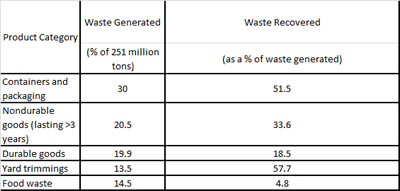 |
MSW Waste Recovery is Making a Difference
Waste from homes and businesses comprises the MSW produced in the United States and in 2012 that waste amounted to about 251 million tons. On a daily basis, each of us generated about 4.38 pounds of trash in 2012, which while coming down from a high of 4.69 pounds in 2005, was well above the 2.68 pounds recorded in 1960. However, when factoring waste recovery via composting, recycling, and combustion for energy into the equation, the net per capita discard rate to landfills was 2.36 pounds per day, which is actually lower than the 1990 per capita rate of 3.19 pounds per day.
The two top ways to divert waste from landfills are recycling and composting (at 65.3 and 21.3 million tons respectively), totaling almost 87 million tons of trash in 2012. But which wastes are most often recycled or composted?
Comparing individual “waste streams generated” to “waste streams recovered” in 2012, it’s easy to see where opportunities for improvement may be found:

Forget expensive calls to lawyers and consultants. With Enviro.BLR.com, you get instant access, 24/7. Try it out today and get the 2014 EHS Salary Guide, absolutely free. Download Now.
Another way to look at waste is by product, something that may also lend itself to making purchasing decisions that line up with waste reduction goals, as well as to gain a better understanding of what products are most recycled and recyclable.
The following table shows how the EPA defines product categories as well as comparing how well each category fared in recycling and composting overall:

Within some product categories, there are also specific waste streams that warrant attention. For example, within the containers and packaging category, more than 76% of paper packaging and 72% of steel packaging were recovered while plastics lagged behind at only about 14%. In addition, individual products also are ranked for recovery (measured by percentage of generation) as follows:
1) Lead-acid batteries – 96%
2) Corrugated boxes – 91%
3) Steel cans – 71%
4) Newspapers/mechanical papers – 70%
5) Major appliances – 64%
6) Aluminum cans – 55%
7) Tires – 45%
8) Mixed paper – 43%
Everything You Need for Environmental Compliance
Enviro.BLR.com puts everything you need at your fingertips, including practical RCRA, CAA, CWA, hazardous waste regulatory analysis and activity, news, and compliance tools. Try it at no cost or risk and get a FREE report.
The easiest way to make sense of the numbers is when they are applied to real-world emission reductions. For example, according to the EPA, in 2012 our 87 million tons of recycled or composted waste provided an annual benefit of more than 168 million metric tons of carbon dioxide equivalent (MMTCO2E) emissions reduced, comparable to the annual GHG emissions from more than 33 million passenger vehicles. Broken down by material type, here are some of the individual GHG benefits realized by MSW waste recovery:

Whether you need facts about GHG emissions or some other important environmental issue, Enviro.BLR.com provides all the information you need, 24/7.
This essential online environmental management tool puts practical RCRA, CAA, CWA, hazardous waste regulatory analysis and activity, news, and compliance tools at your fingertips whenever you need it. With instant access, your expensive calls to lawyers and consultants, and the risk of costly mistakes from “not knowing,” are a thing of the past.
A basic subscription includes detailed environmental information and tools on federal EPA and 1 state. All 50 states are available. Full text regulations are also available as a low-cost option.
Your subscription includes:
- State-specific regulatory analysis
- Continuous regulatory updates—more than 500 posts each month
- Hundreds of compliance and training tools
- Environmental best practice and white papers
- “Site Navigator,” a powerful, easy-to-use search
- 3-day expert answers to your questions from our editors
If you’d like to personally evaluate Enviro.BLR.com and see how it can help you comply with environmental requirements, we’ll be happy to provide a no-cost, no-obligation tour of the website. Just let us know, and we’ll arrange it. Plus, for a limited time receive the 2014 EHS Salary Guide, absolutely free.
